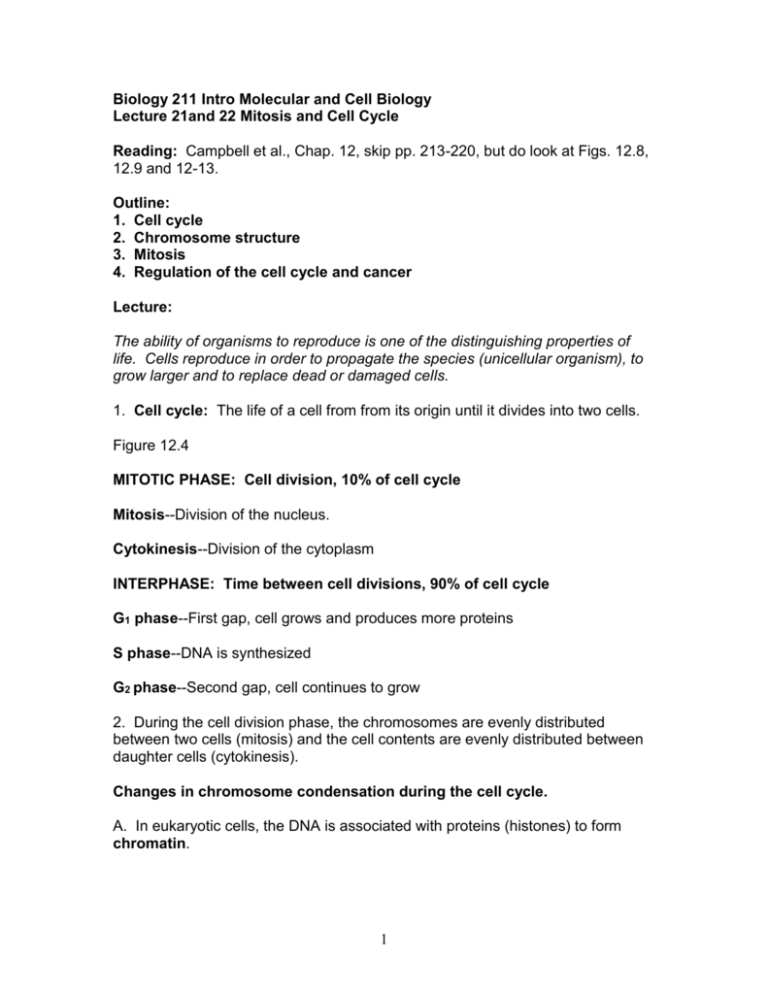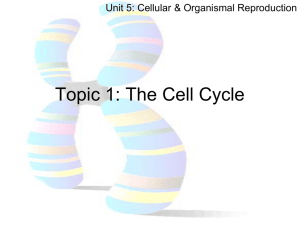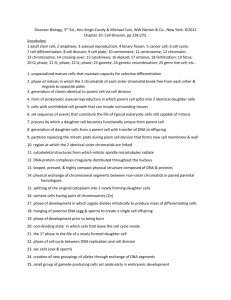Biology 211 Intro Molecular and Cell Biology
advertisement

Biology 211 Intro Molecular and Cell Biology Lecture 21and 22 Mitosis and Cell Cycle Reading: Campbell et al., Chap. 12, skip pp. 213-220, but do look at Figs. 12.8, 12.9 and 12-13. Outline: 1. Cell cycle 2. Chromosome structure 3. Mitosis 4. Regulation of the cell cycle and cancer Lecture: The ability of organisms to reproduce is one of the distinguishing properties of life. Cells reproduce in order to propagate the species (unicellular organism), to grow larger and to replace dead or damaged cells. 1. Cell cycle: The life of a cell from from its origin until it divides into two cells. Figure 12.4 MITOTIC PHASE: Cell division, 10% of cell cycle Mitosis--Division of the nucleus. Cytokinesis--Division of the cytoplasm INTERPHASE: Time between cell divisions, 90% of cell cycle G1 phase--First gap, cell grows and produces more proteins S phase--DNA is synthesized G2 phase--Second gap, cell continues to grow 2. During the cell division phase, the chromosomes are evenly distributed between two cells (mitosis) and the cell contents are evenly distributed between daughter cells (cytokinesis). Changes in chromosome condensation during the cell cycle. A. In eukaryotic cells, the DNA is associated with proteins (histones) to form chromatin. 1 B. Prior to cell division, DNA synthesis occurs and the chromatin condenses to form chromosomes. The number of chromosomes is a unique property of each species; humans have 46 chromosomes. Parts of a chromosome: Sister chromatids: Two halves of a duplicated chromosome. Centromere: Constriction on chromosome where the duplicated chromosomes are attached to each other. Kinetochore: Proteins at the centromere that the chromosome uses to attach to the mitotic apparatus. Mitotic spindle: Structure that assembles to separate the chromosomes during mitosis. Made of microtubules: Long filament formed from tubulin protein subunits. Poles are organized by centrosomes. 3. Mitosis--Series of events in the nucleus of cells that divides the genetic material evenly between daughter cells. Distinct subphases: Figure 12.5 A. prophase--Chromosomes condense and become visible. Mitotic spindle (microtubule structure) begins to form. B. metaphase--Nuclear envelope breaks down. Chromosomes attach to the spindle and line up in the middle of the cell (=metaphase plate). C. anaphase--Centromeres divide and daughter chromosomes migrate to opposite poles. Chromosome movement is due to depolymerization of microtubules and motor proteins carrying chromosome toward ends of microtubules. D. telophase--Daughter nuclei reform, chromosomes become more dispersed, and cytokinesis (cytoplasmic division) occurs. Cytokinesis Animal cells: Cleavage furrow forms between daughter cells. Plant cells: Cell plate forms between daughter cells. 2 4. Regulation of the cell cycle and cancer Frequency of cell division varies with the type of cell. Some cells do not divide at all in adults. Cell division is tightly controlled at "checkpoints". For example, a critical checkpoint is at the boundary between G1 and S. Many cells "exit" the cell cycle switching to a non-dividing state called G0. Cells that are in G0 do not divide unless environmental signals are received such as growth factors. Cancer cells have escaped from cell cycle controls. Normal cells Cell division controlled Too many cells--growth stops Cancer cells Cell division out of control Too many cells--growth continues; growth not density inhibited Cells escape from their normal location and spread throughout the body=metastasis Often abnormal numbers of chromosomes Mutations in several genes for proteins involved in cell growth DNA damage not repaired Cells in the correct location Normal number of chromosomes Normal proteins controlling cell growth Repair of DNA damage Progression of a normal cell to a cancer cell: 1. Single cell is exposed to radiation or chemicals. 2. Damage to DNA is not repaired or cell has a defect in the enzymes of DNA repair. 3. Damage alters some genes for proteins controlling cell growth (these are often called oncogenes). Usually 2-5 genes are altered. 4. Cells beginning to divide when they should be resting. Too many cells are formed. A tumor is a mass of abnormal cells in normal tissues. 5. If tumor remains at the original site and does not spread, it is a benign tumor and usually can be removed by surgery. 6. If cells leave the site of the original tumor, it becomes metastatic, spreading to other parts of the body. Cancers that spread are more likely to be malignant (may lead to death). 3








